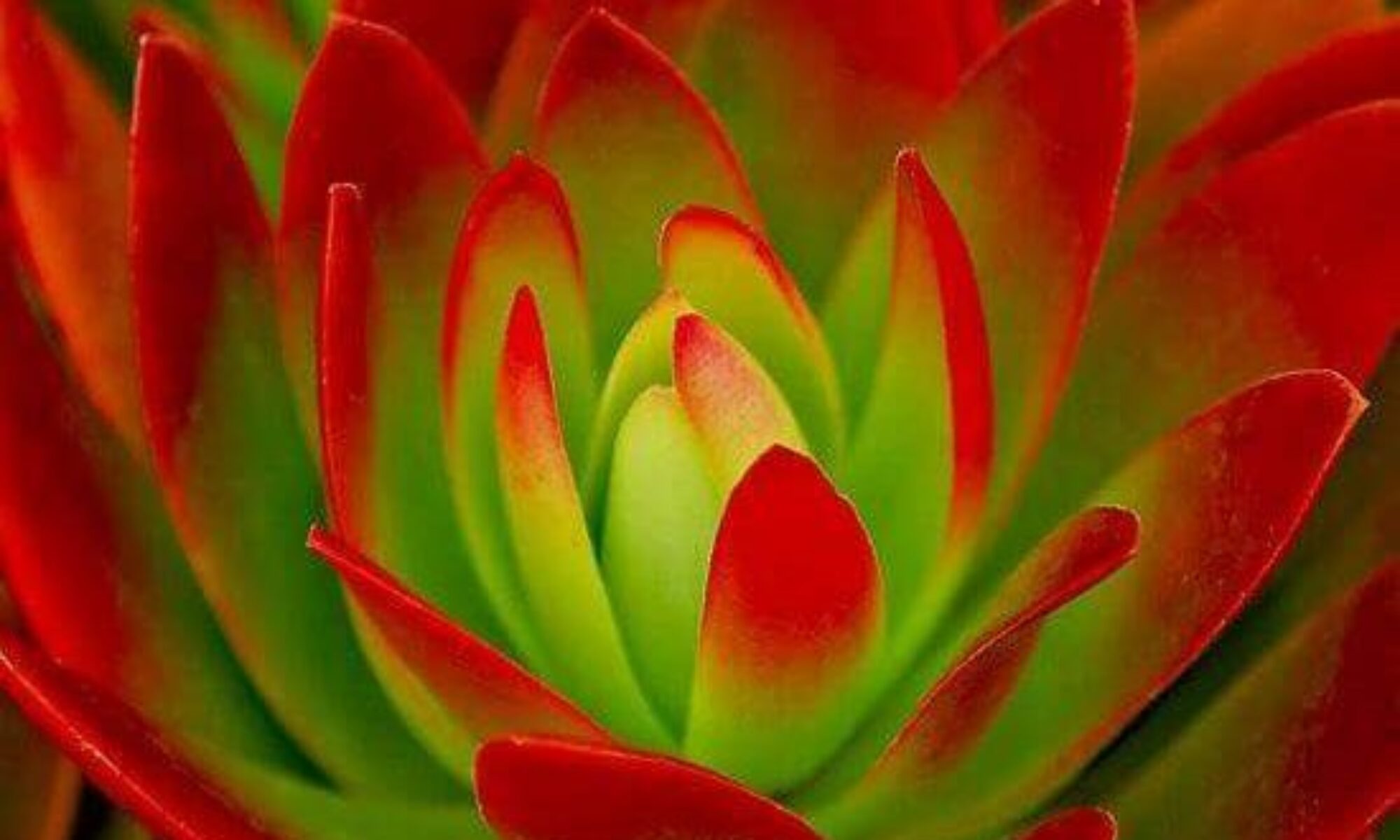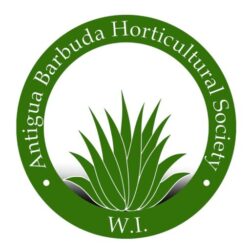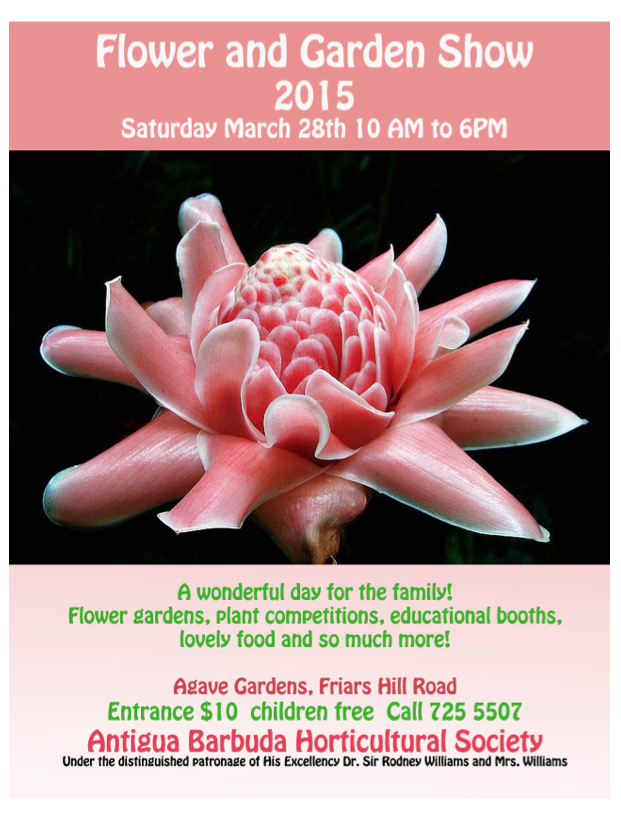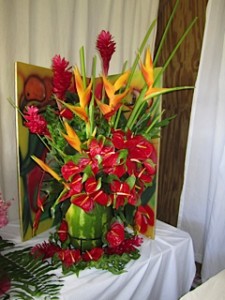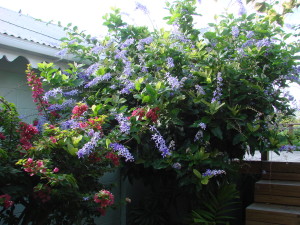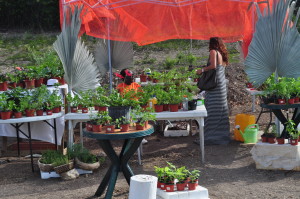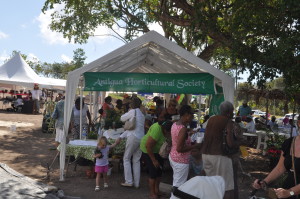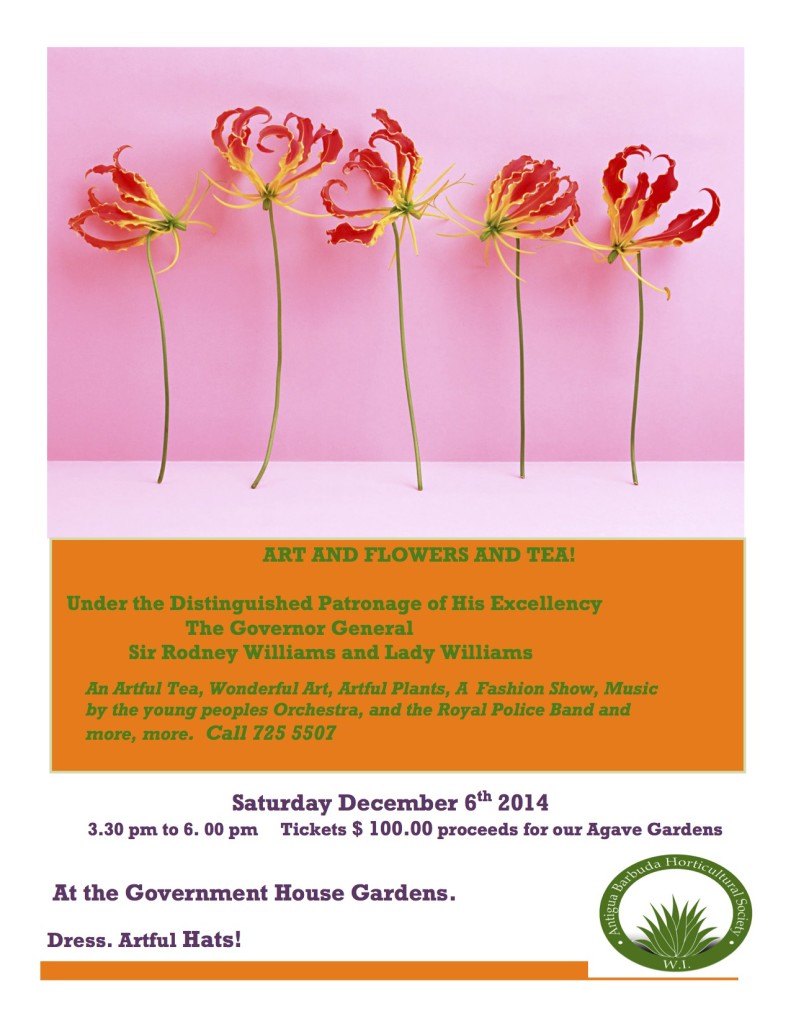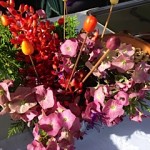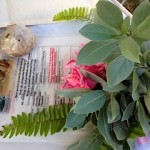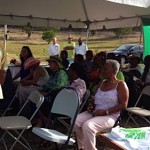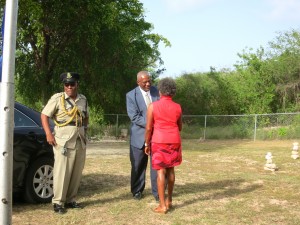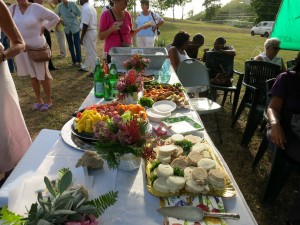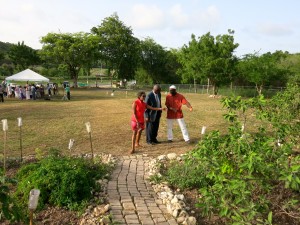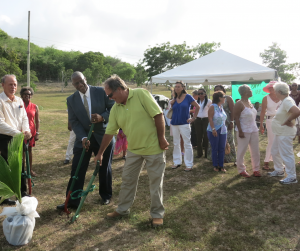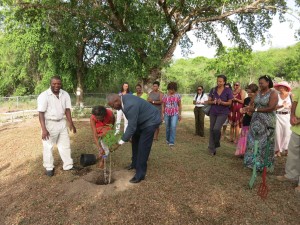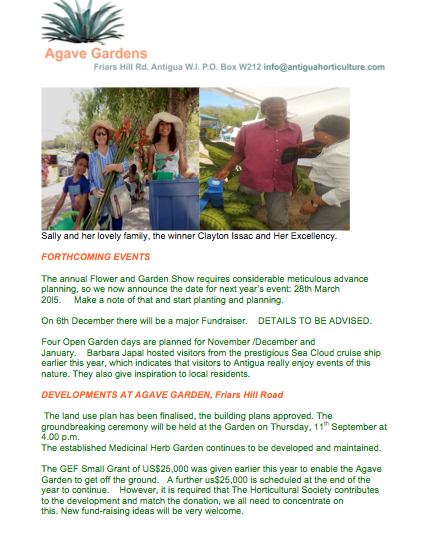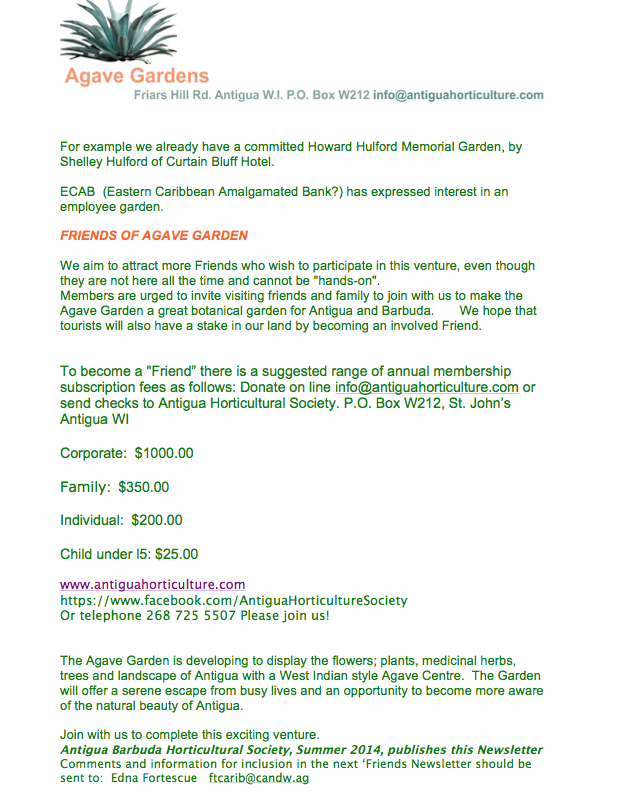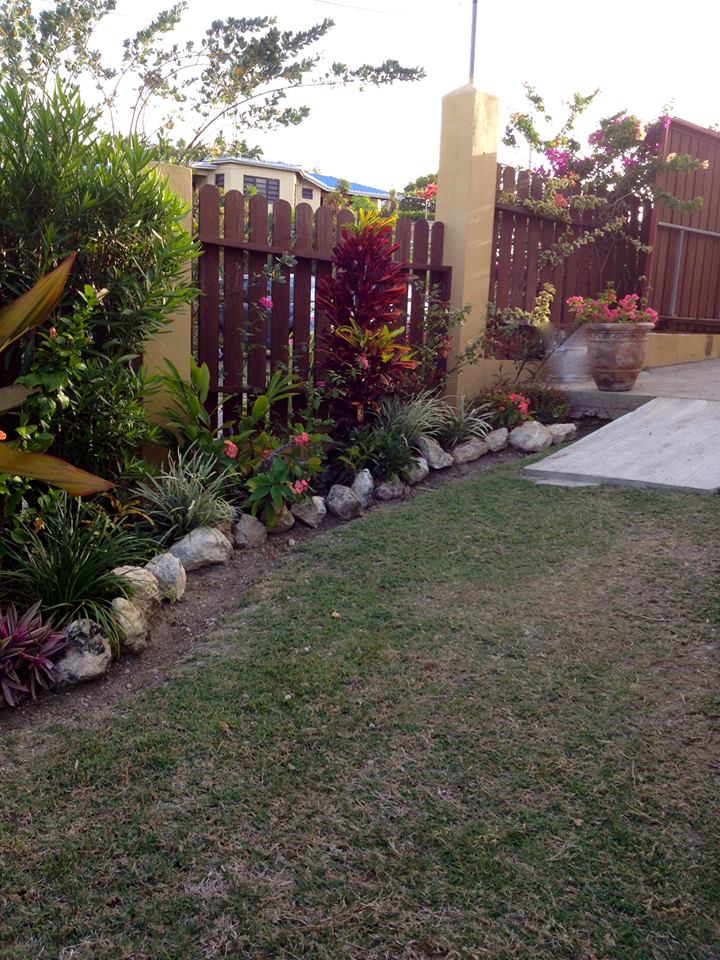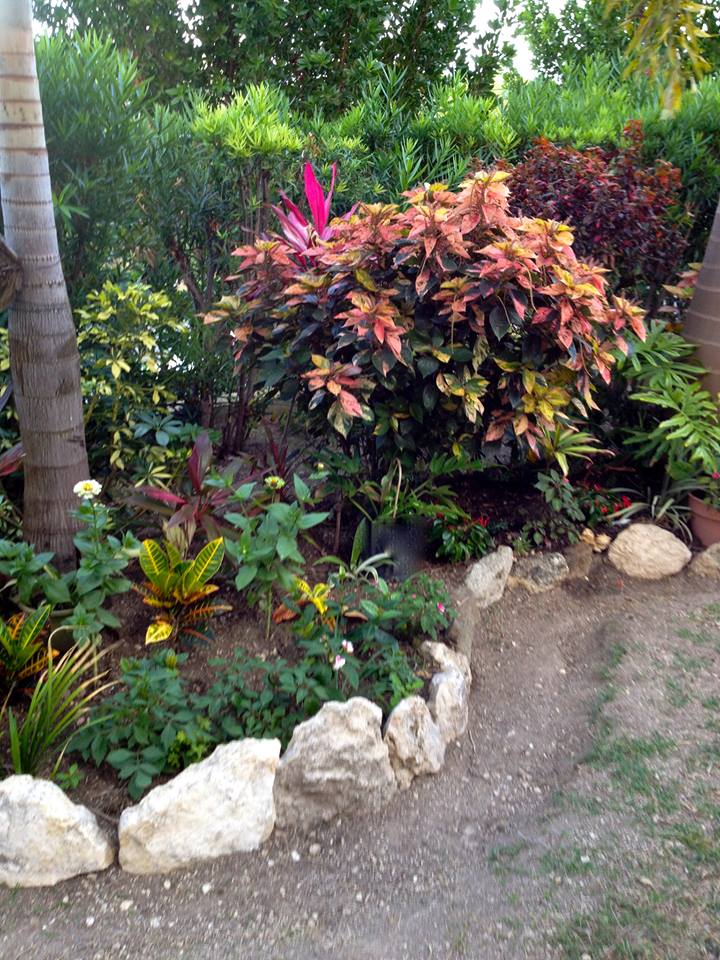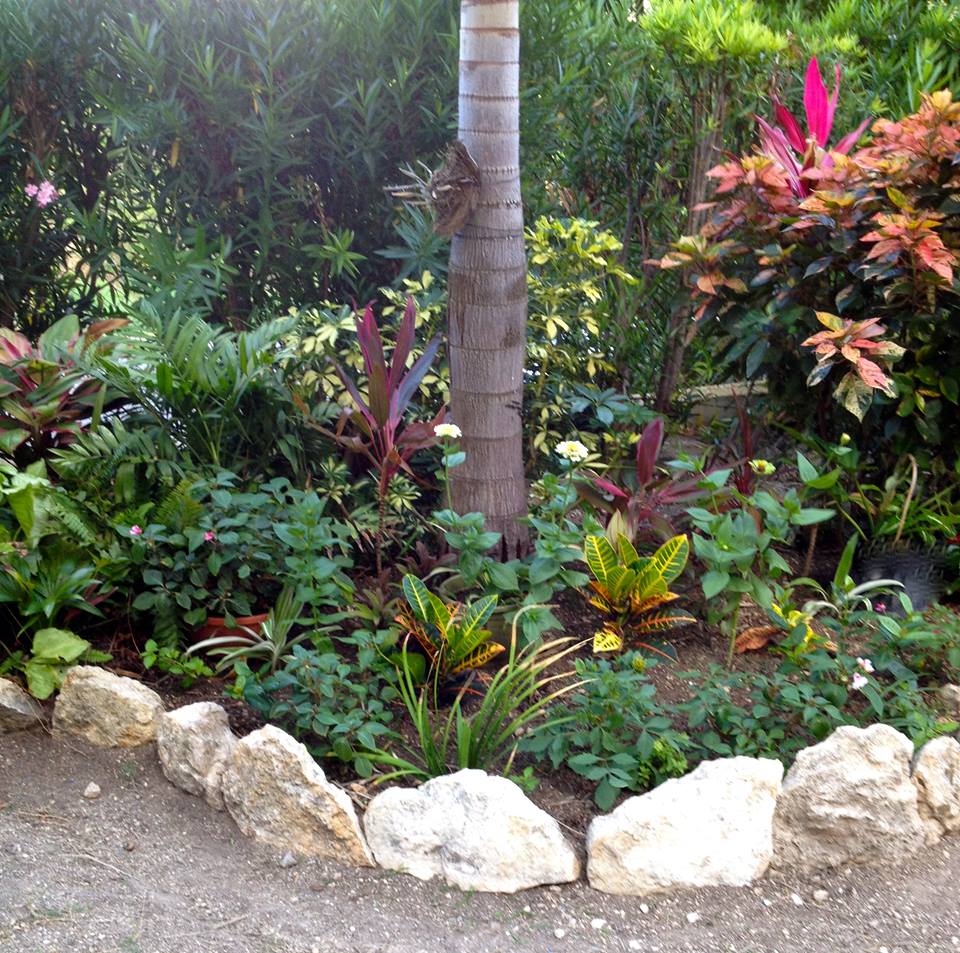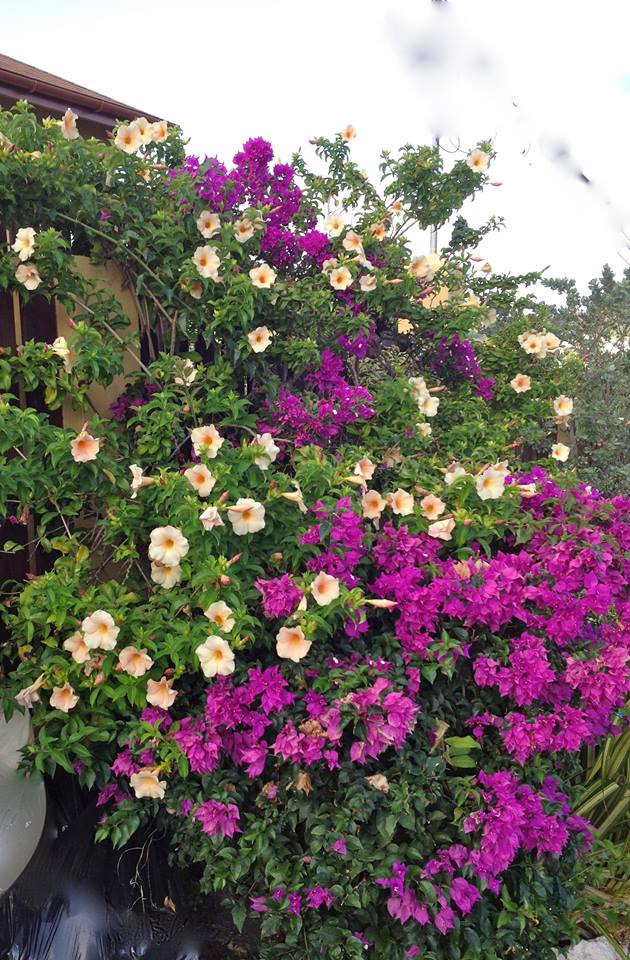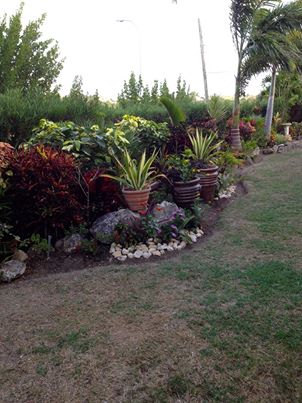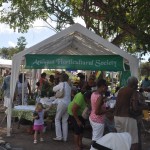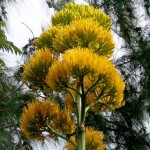2015 Flower and Garden Show, Saturday, March 28th 2015
Annual Tea Party December 6th 2014
We have done it! Ground breaking ceremony!
Friends of the Agave Gardens Summer newsletter # 2
July 2014 Newsletter
ANTIGUA BARBUDA HORTICULTURAL SOCIETY NEWSLETTER # 5
JULY 2014
Hello Members and Friends,
Happy summer to all, we are on a little holiday, but we are all gardening, despite too many dry days and little water, we persevere.
Our Face book page with the postings of our secretary Generis <generis.hodge@gmail.com> contact her with your information we are over 200 likes and we invite you to follow us and like us, great material and educational posts. https://www.facebook.com/AntiguaHorticultureSociety
Events are updated on our web site www.antiguahorticulture.com
and our blog carry current information, we invite you to keep it current and visit often.
Page 1:
Here is a look at our show:
Winners: Antigua Barbuda Flower and Garden Show 2014 Winners
Mr. Clayton Isaac- Best In Show
Best Booth: Mrs. Pat Simon-Forde
Mrs. Ann Hicks
Mrs. Generis Hodge
Mrs. Delrose Hixon
Mrs. Tina Zaleski
Mrs. Anne Marie Delisle
Mrs. Agnes Meeker
Mrs. Luana Isaac
Ms. Lorraine Davis
Mrs. Jackie Feracho Williams
Flower World
Mr. Monty Lewis
Mrs. Rose Simon
Mr. Fred Salandy and Alicia George
Mrs. Barbara Japal
A message from the Orchid Society From Mrs. Peggie Samuel, President.
Antigua Barbuda Orchid Society is a new society committed to Orchid Preservation
through education and information.. Antigua Barbuda Orchid Society is a friendly society whose purpose is to share our passion and love for orchids in an informal and nurturing environment. Our meetings provide an opportunity
for people to tap the wealth of knowledge presented by our guest speakers on orchids.
Our Motto: growing our nation one orchid at a time.
information can be obtain from calling Peggie 268-776-6183.
As we are all aware we have engaged Sam Fuller Landscape Architect to render our land use and she has submitted a preliminary, work in progress ….
Patrick Ryan, Chair of the building committee has advised that we await the approvals from DCA. We are delayed with the political change over.
We are reviewing the serious Lethal Yellowing of our Palms, we must keep
everyone informed.
Symptoms and Signs:
Our Palms continue to be infected at an alarming rate
No single symptom is diagnostic of lethal yellowing. Symptoms are variable among palms and in the case of coconuts, among cultivars. It is the pattern of appearance and chronological progression of symptoms that accurately identifies the disease.
Confirmation of lethal yellowing is based on many symptoms, at least 36 palm species have been documented as susceptible to lethal yellowing, but coconut palm (Cocos nucifera) is most vulnerable to the disease, followed by Pritchardia species, Christmas palm (Adonidia merrillii), and date palm (Phoenix dactylifera).
Once the disease is confirmed, the palm must be destroyed, cut down and burned.
Calendar of events
Next General Meeting Thursday August 14th 2014 venue to be announced.
December 6th 2014 Fund raiser (to be determined)
March 28th 2015 Flower and Garden Show
Garden visit 5/1/2014
Here’s more results from our wonderful show, winner of the best booth, Mrs. Pat Simon Forde
Friends of ABHS Newsletter 1
FRIENDS OF THE AGAVE GARDEN NEWSLETTER Spring 2014
Welcome to the first edition of The Friends’ Newsletter. This will be emailed quarterly to the Friends and those expressing interested in joining this group of special supporters of Antigua’s Agave Garden, home of The Antigua & Barbuda Horticultural Society.
We would like to thank the following new Friends who have recently joined us:
Mr. Peter and Gwen Norton, New York City
Ms. Sharon Senko Academic Arrangements Abroad, New York City
Mrs. Kelsey Sparks, Isanti, Minnesota
Mrs Agi Clark, West Taghkanic, New York
Mr. Patrick Ryan and company, Antigua WI
Application Information to become a Friend to the Agave Gardens is given at the end of the Newsletter. COME AND JOIN US!
BACKGROUND OF THE AGAVE GARDEN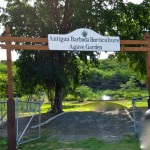
The Government of Antigua and Barbuda presented the strategically located 2 acres of land on Friars Hill Road to The Antigua & Barbuda Horticultural Society in 1982.This gently sloping wooded ground, well placed to attract Antiguans and visitors, was the subject of much discussion by members as to the best way to proceed with development to provide a Centre for the Society and a much-needed garden to demonstrate the great variety of plants and trees in our twin islands and the many facilities which such a garden should offer.
The land was cleared, leaving important growth in situ, and properly fenced thanks to the generous contribution of Patrick Ryan and company and the Horticultural Society.
It was then professionally surveyed so that sites for the required aspects were determined. An attractive gate was constructed and the trademark Agave plants placed outside the perimeter.
Plans were developed for the main building that will house a meeting room, library, greenhouse, shop, bathroom facilities and cafeteria. The structure will be of a traditional West Indian design, to be officially approved, and decorated with all the features, which we historically associate with our architectural heritage.
FINANCING
The Society applied for a GEF small grant, the initial donation of US$25,000, was received earlier this year with an additional $25,00 to complete phase one of the project by year’s end.
This was added to the funds that had accumulated in the bank account over several years, to provide a basis for the development. However, it was made clear that the Society was expected to match this generous donation by raising equivalent funds, and other reasonable stipulations are in place.
The paramount importance of financing is why the participation of the Friends and the increasing of membership are so vital to the project that aims to attract international awareness and support. It is hoped that while many of the Friends may not be resident in Antigua, they will follow events with the Newsletter, address any related queries to the Society, and participate whenever possible. Meanwhile it is aimed to increase the members of the Horticultural Society locally, and it is hoped they will enthusiastically attend regular meetings to deal with ongoing matters and be consulted on all relevant activities.
One requirement of the financial injection by the end of 20l4 is the construction of the basic main building, and this is the dream to become reality of all involved. A young local architect, Mrs. Simone Hadeed, is already working on the preliminary plans.
THE ANNUAL FLOWER SHOW
This is the most important event in the calendar, and the 20l4 event will take place at the Agave gardens on April 12 and 13th the weekend before Easter, admission $10 adults, children free. Give family and friends the gift of a beautiful plant or a membership.
RELATED ACTIVITIES
An indication of the spin-off from the increased awareness of horticulture in Antigua is the fact that Barbara Japal hosted two groups from the exclusive cruise ship Sea Cloud 2 at her own beautiful garden on Lindsay Hill and the garden of another member Mr. Clement Samuel.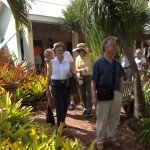
This group was participants in a National Trust Tour led by famous author Mr. Patrick Bowe of GARDENS OF THE CARIBBEAN and local ships’ agent Alexander Parrish. This horticultural tour operation will be developed by the society since many discerning cruise passengers, particularly those who are not so young, require more of the environmental tours and garden visits.
Land based visitors too are looking for an added dimension to their stay and
would like to know more about the beautiful flora and landscape around them.
INFORMATION REGARDING HORTICULTURAL QUERIES AND PROBLEMS
The Society aims to provide a “hot line” for queries. It is also concentrating on major problems that arise, such as Lethal Yellowing of our palm trees, which is posing a threat to the very essence of Antigua’s attraction.
Information on progress and new treatments will be posted in the Newsletter.
To become a “Friend” there is a range of annual membership subscription fees as follows: Donate on line info@antiguahorticulture.com or send checks to Antigua Horticultural Society. P.O. Box W212, St. John’s Antigua WI
Corporate: $1000.00
Family: $350.00
Individual: $200.00
Pensioner: $50.00
Child under l5: $20.00
https://www.facebook.com/AntiguaHorticultureSocietyOr telephone 268 725 5507
Please join us!
Antigua Barbuda Horticultural Society, Spring 2014, publishes this Newsletter
Comments and information for inclusion in the next ‘Friends Newsletter should be sent to:
Edna Fortescue ftcarib@candw.ag
Agave Flower
Lethal Yellow redress
Horticultural Society networks to address lethal yellowing
St. John’s Antigua- A non-profit organisation which deals with the protection of the country’s flora and fauna is coming to the aid of the government as it seeks to rid the country of the lethal yellowing disease.
President of the Antigua & Barbuda Horticultural Society Barbara Japal said her organisation is looking at instituting a number of programmes to help create a greater level of awareness.
The group is in the process of connecting with regional bodies to complement the work of the government.
Japal said the Society would be seeking to address the devastating disease by collaborating with other organisations across the region also affected by the virus.
“We have dialogued with horticulture societies in our neighbouring islands – Barbados, St Kitts and Nevis to share their experiences on a weekly basis just to keep us up to date with what’s going on,” Japal said.
She said the Society will also be producing information materials to be made available on its website.
Japal continued that, during the last four decades, outbreaks of lethal yellowing disease have killed most of the once prevalent taller coconut cultivars in parts of Florida and some Caribbean islands.
The president added that while coconuts are the most economically important palms affected by the disease, 35 other palm species are also susceptible to lethal yellowing.
The government, over the past few months, has been moving speedily to tackle lethal yellowing which has the potential to wipe out the country’s coconut industry.
Lethal yellowing results in the premature shedding of fruits and causes the leaf to become yellow, resulting in the plant dying within three to six months of the disease appearing.
The Plant Protection Unit, headed by Dr Janil Gore-Francis, has been tasked with rolling out a management plan to control the disease.
